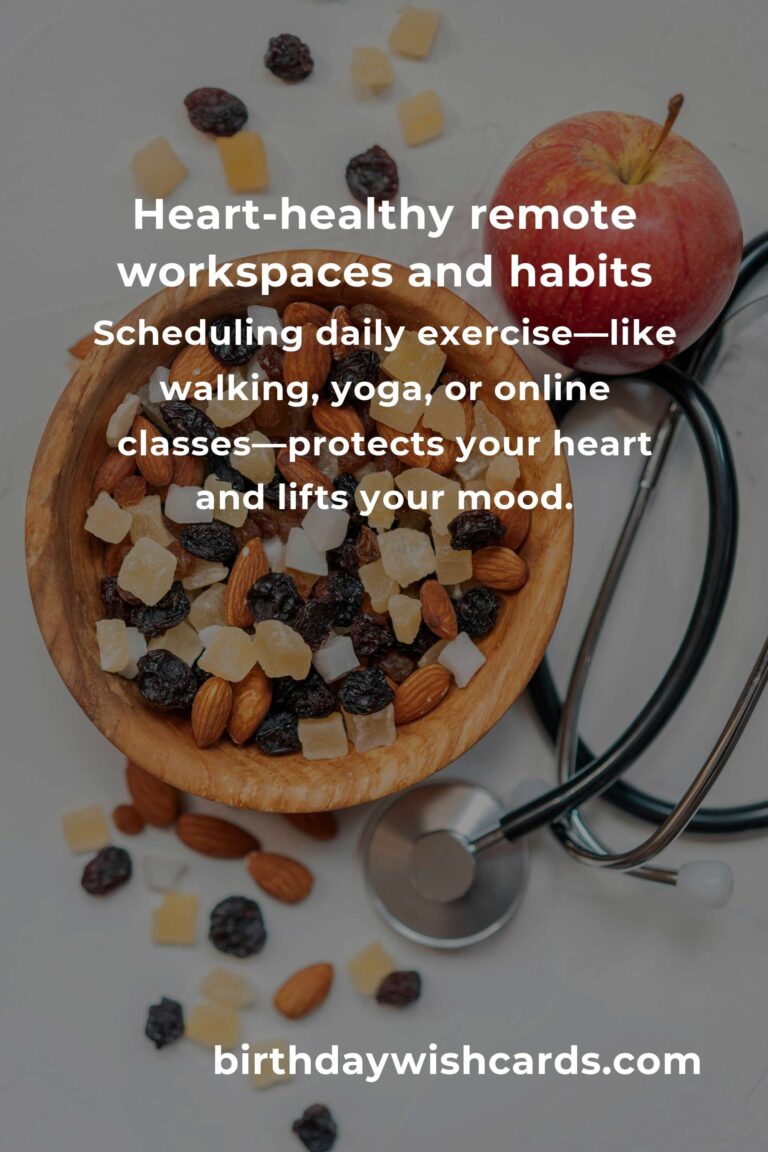
As the world continues to embrace remote work, our lives and routines have changed dramatically. While working from home offers flexibility and freedom, it also presents unique challenges—especially when it comes to heart health. In 2025, remote workers face an unprecedented blend of convenience and risk. Sedentary lifestyles, blurred work-life boundaries, and digital overload can quietly erode our most vital organ’s well-being. But with awareness and action, remote work can fuel not just productivity, but a vibrant, heart-healthy life.
Understanding the Remote Work Revolution
Over the past decade, remote work has shifted from a trend to a norm. In 2025, more than 60% of professionals globally are estimated to work at least part-time from home. The benefits are clear: less time commuting, more flexibility, and increased autonomy. However, this new normal also means longer hours sitting, more time in front of screens, and less social interaction—all of which can negatively affect heart health if left unchecked.
The Hidden Heart Risks of Working from Home
At first glance, remote work appears to be a boon for well-being: you can make your own meals, set your schedule, and avoid the stress of traffic. But beneath the surface, several risks can quietly undermine your cardiovascular health:
- Prolonged Sitting: Sitting for hours at a time slows circulation, raises cholesterol, and increases the risk of heart disease.
- Unhealthy Snacking: Easy access to the kitchen and stress can lead to frequent, unhealthy snacking, often high in salt and sugar.
- Lack of Physical Activity: Without a commute, walking to meetings, or lunch breaks, daily steps can plummet.
- Increased Stress: Blurred work-life boundaries, job insecurity, and digital overload can heighten stress hormones like cortisol, harming the heart.
- Poor Sleep: Screen time late into the night and flexible schedules can disrupt sleep patterns, a crucial factor in heart health.
Why Heart Health Matters More Than Ever
Your heart isn’t just a muscle—it’s your life’s engine. Cardiovascular disease remains the world’s leading cause of death, and its risk factors—like high blood pressure, high cholesterol, obesity, and diabetes—are all influenced by lifestyle. The remote work era offers new freedom, but also new temptations that, if unchecked, can increase these risks. Proactively protecting your heart isn’t just about avoiding disease; it’s about fueling energy, focus, and joy in every aspect of your life.
Top Strategies for Heart Health in Remote Work
So, how can remote workers in 2025 safeguard and strengthen their hearts? Here’s your comprehensive, actionable guide:
1. Design an Active Workspace
Move beyond the static desk. Consider these tips:
- Standing desks: Alternate between sitting and standing throughout the day.
- Movement reminders: Use apps or smartwatches to prompt you to get up every 30-60 minutes.
- Walking meetings: Take calls while walking around your home or outside.
- Desk exercises: Incorporate stretches, calf raises, or squats during breaks.
2. Prioritize Heart-Healthy Nutrition
Remote work gives you control over your meals—use it to your advantage:
- Meal prepping: Prepare healthy snacks and meals in advance to avoid impulse eating.
- Focus on whole foods: Choose fruits, vegetables, whole grains, lean proteins, and healthy fats.
- Limit sodium and sugar: Read labels, and watch out for processed foods.
- Stay hydrated: Keep a water bottle at your desk and limit sugary drinks.
3. Build Regular Exercise into Your Routine
Physical activity is a cornerstone of heart health:
- Morning or lunchtime workouts: Schedule exercise as if it’s a meeting you can’t miss.
- Mix it up: Combine cardio (like brisk walking, cycling, or jogging) with strength training.
- Use online classes: Take advantage of virtual fitness classes or YouTube tutorials.
- Track your progress: Fitness wearables make it easy to set and achieve goals.
4. Manage Stress Mindfully
Chronic stress is a silent contributor to heart disease. Adopt these strategies:
- Mindfulness meditation: Start your day with a 5-10 minute meditation or breathing exercise.
- Set clear boundaries: Define work hours and stick to them to avoid burnout.
- Connect socially: Schedule virtual coffee breaks or after-work calls with friends.
- Unplug after hours: Turn off notifications and step away from screens in the evening.
5. Optimize Sleep for Heart Health
Quality sleep is essential for heart repair and recovery:
- Consistent schedule: Go to bed and wake up at the same time daily.
- Screen-free wind-down: Avoid screens for at least 30 minutes before bed.
- Comfortable environment: Invest in a good mattress, blackout curtains, and keep your room cool and quiet.
- Limit caffeine: Avoid coffee or energy drinks in the late afternoon and evening.
Future-Proof Your Heart: Embracing Digital Wellness
In 2025, digital health tools have evolved remarkably. Embrace these advancements to support your heart:
- Wearable health monitors: Smartwatches now track not just steps, but heart rhythms and stress levels in real time.
- Personalized nutrition apps: AI-powered apps suggest meal plans based on your biometrics.
- Telehealth check-ups: Virtual visits make it easier to stay on top of blood pressure, cholesterol, and medication needs.
- Digital support groups: Online communities provide motivation, tips, and accountability for healthy habits.
Personal Stories: Remote Workers Who Transformed Their Heart Health
Sometimes, the best motivation comes from real people. Here are three stories from remote workers who took charge of their heart health:
Emma’s Journey: From Burnout to Balance
Emma, a software developer, struggled with 12-hour days at her laptop and endless snacking. After a health scare in 2023, she revamped her routine: standing desk, 10,000 steps a day, and meal prepping on Sundays. Her cholesterol dropped, her energy soared, and she rediscovered joy in both work and life.
Raj’s Revival: Moving More, Stressing Less
Raj, a remote marketing manager, battled anxiety and sleepless nights. He incorporated daily yoga, set strict work hours, and joined a virtual running group. By 2025, he not only lost 15 pounds but also found a new sense of peace and connection.
Lisa’s Leap: Tech Tools for Transformation
Lisa, a freelance writer, used wearable tech to monitor her heart rate and stress. She loved the insights and motivation, and now swears by lunchtime dance breaks and AI-powered meal plans. Her heart feels stronger, and her creativity has never been better.
Remote Work, Real Risks: Watch Out for These Warning Signs
Even with the best intentions, it’s important to watch for warning signs that your heart might be struggling. Contact a healthcare professional if you notice:
- Chest pain or tightness, especially during activity or stress
- Shortness of breath, unexplained fatigue, or dizziness
- Irregular or rapid heartbeat
- Swelling in your legs, ankles, or feet
Early intervention can save lives. Don’t ignore your body’s signals—your heart deserves attention and care.
Building a Heart-Healthy Remote Work Culture
Heart health isn’t just an individual responsibility—it’s a collective one. In 2025, forward-thinking companies are prioritizing well-being. Here’s how workplaces can help:
- Offer wellness stipends for fitness equipment or healthy meal delivery
- Encourage regular breaks and walking meetings
- Provide access to virtual fitness classes or mindfulness apps
- Foster a culture of work-life balance and psychological safety
If your workplace isn’t there yet, advocate for these changes. Your voice can help shape a healthier, happier remote work world.
Your Heart-Healthy Action Plan for 2025 and Beyond
Ready to get started? Here’s a simple checklist to keep your heart strong as a remote worker:
- Set up an ergonomic, movement-friendly workspace
- Prep heart-healthy meals and snacks each week
- Schedule daily exercise and stand-up breaks
- Practice stress management and set work-life boundaries
- Prioritize quality sleep with a relaxing routine
- Leverage digital health tools for tracking and support
- Advocate for a heart-healthy work culture with your employer
Remember: small, consistent changes build lifelong heart health. Each step you take isn’t just about preventing disease—it’s about living with more energy, clarity, and joy every day.
Conclusion: Thriving in the Digital Age
Remote work in 2025 is full of promise—but only if we rise to its challenges. By prioritizing heart health, remote workers can unlock not just productivity, but fulfillment and longevity. You have the power to write your own heart-healthy story. Start today—your future self will thank you.
Remote work brings both freedom and new health challenges, especially for your heart.
Sitting for long hours, unhealthy snacking, and stress can quietly raise heart disease risk.
Designing an active workspace and taking regular movement breaks is essential for circulation.
Preparing heart-healthy meals at home empowers better nutrition and reduces temptation.
Scheduling daily exercise—like walking, yoga, or online classes—protects your heart and lifts your mood.
Mindfulness, clear work-life boundaries, and social connection are key to managing stress.
Quality sleep helps your heart repair and keeps you energized for work and life.
Digital health tools in 2025 make it easier than ever to track and improve heart well-being.
Watch for warning signs like chest pain or fatigue, and never ignore your body’s signals.
Taking small, consistent steps now means a stronger, happier heart for years to come.
#HeartHealth2025 #RemoteWorkWellness #DigitalAgeHealth #HealthyHomeOffice #ThriveRemotely #HealthyHeartHabits #WorkLifeBalance #StayActiveAtHome #MindfulRemoteWork #WellbeingAtWork

